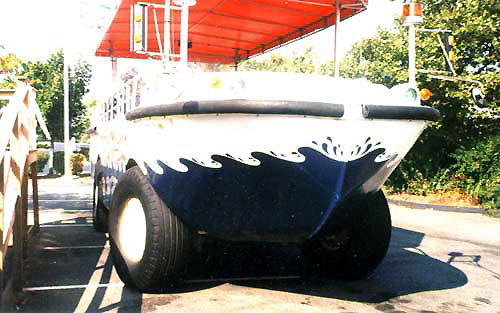 |
||||||||||||||||
|
|
||||||||||||||||

LARCS - Lighter, Amphibious Re-Supply Cargo, 5-Ton (LARC-V)
The LARC-5 (Lighter Amphibious Resupply Cargo) is an Army amphibious vehicle originally used in the 1960's to ferry supplies from ships to shore. Its total possible load is 5 tons (hence the five after LARC). The head of the Transportation Corps, MG Paul Yount, directed the US Army Research Command (USATRECOM) in 1956 to build a boat with the ability to drive on land. The prototype was built in July 1959 with final design produced in 1963. They LARC V did not handle the way it was expected so, many were given to around 35 reserve companies. The active duty 165th, 305th, 344th, 458th, and 461st Trans Co’s received them. The LARC V is primarily used by the Beach Group in surf-zone salvage, recovery, and command and control roles, and for the transportation of personnel and equipment. The craft are in excess of 35 years old and require extensive maintenance and repair, nevertheless their retention or replacement is considered essential. The LARC V is a single-screw, four-wheeled, self-propelled, diesel-powered amphibian. It has a cargo capacity of 10,000 pounds and a troop capacity of 20. It has a range of 200 nautical miles on land and 40 nautical miles on water. It can attain speeds up to 22 miles per hour on land and 8.5 knots at sea. 12 LARC V craft are presently embarked aboard MPF ships. The LARC(V)is an amphibious lighter constructed of aluminum, 35 feet long, 10-ft wide, and 10-feet 2 inches high. The current weight of the craft is approximately 20,000 pounds (without cargo). Power is furnished by an 8 cylinder Cummins V-903 Engine (rated at 295 BHP at 26000 rpm). The craft is capable of operation in temperate, tropic, and arctic climates, traveling on sand and coral beaches, unimproved roads, off-road terrain and maneuvering through a surf of 10-foot breakers. The engine is located in the stern over the propeller and drives forward to a centrally located transfer case where power is transmitted to all four driving wheels and/or the propeller. The suspension is rigid and the 18.00 x 12 ply off-road tubeless tires provide the only shock absorption. The propeller operates in hull tunnel, which is fitted with a nozzle to improve efficiency. Baseline speeds for the craft were 9 mph in water and 30 mph on land with full rated load of 5 short tons. Thirty-five modifications have been identified that will form the nucleus of a SLEP for the craft. This SLEP would improve safety, reduce crew fatigue, improve reliability, reduce maintenance costs, and increase service life. Studies must be conducted to explore future capabilities to conduct surf zone salvage, recovery, command and control, and the transportation of personnel and equipment. I have designed the survey formats, surveyed and consulted on 12 LARC craft through out the east coast and lake regions.
|
||||||||||||||||










